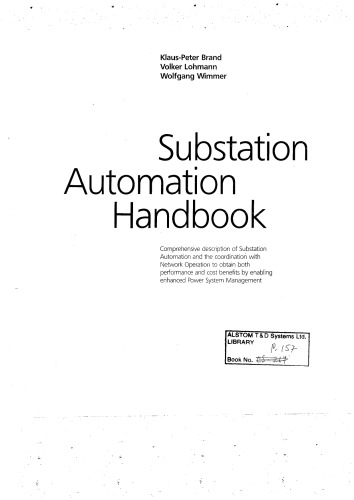

Most ebook files are in PDF format, so you can easily read them using various software such as Foxit Reader or directly on the Google Chrome browser.
Some ebook files are released by publishers in other formats such as .awz, .mobi, .epub, .fb2, etc. You may need to install specific software to read these formats on mobile/PC, such as Calibre.
Please read the tutorial at this link: https://ebookbell.com/faq
We offer FREE conversion to the popular formats you request; however, this may take some time. Therefore, right after payment, please email us, and we will try to provide the service as quickly as possible.
For some exceptional file formats or broken links (if any), please refrain from opening any disputes. Instead, email us first, and we will try to assist within a maximum of 6 hours.
EbookBell Team

4.1
20 reviews
ISBN 10: 1118987209
ISBN 13: 9781118987209
Author: Evelio Padilla
1 Historical Evolution of Substation Automation Systems (SASs)
1.1 Emerging Communication Technologies
1.2 Intelligent Electronic Devices (IEDs)
1.3 Networking Media
1.4 Communication Standards
Further Reading
2 Main Functions of Substation Automation Systems
2.1 Control Function
2.2 Monitoring Function
2.3 Alarming Function
2.4 Measurement Function
2.5 Setting and Monitoring of Protective Relays
2.6 Control and Monitoring of the Auxiliary Power System
2.7 Voltage Regulation
Further Reading
3 Impact of the IEC 61850 Standard on SAS Projects
3.1 Impact on System Implementation Philosophy
3.2 Impact on User Specification
3.3 Impact on the Overall Procurement Process
3.4 Impact on the Engineering Process
3.5 Impact on Project Execution
3.6 Impact on Utility Global Strategies
3.7 The Contents of the Standard
3.8 Dealing with the Standard
Further Reading
4 Switchyard Level, Equipment and Interfaces
4.1 Primary Equipment
4.2 Medium and Low Voltage Components
4.3 Electrical Connections between Primary Equipment
4.4 Substation Physical Layout
4.5 Control Requirements at Switchyard Level
Further Reading
5 Bay Level: Components and Incident Factors
5.1 Environmental and Operational Factors
5.2 Insulation Considerations in the Secondary System
5.3 Switchyard Control Rooms
5.4 Attributes of Control Cubicles
5.5 The Bay Controller (BC)
5.6 Other Bay Level Components
5.7 Process Bus
Further Reading
6 Station Level: Facilities and Functions
6.1 Main Control House
6.2 Station Controller
6.3 Human Machine Interface HMI
6.4 External Alarming
6.5 Time Synchronization Facility
6.6 Protocol Conversion Task
6.7 Station Bus
6.8 Station LAN
Further Reading
7 System Functionalities
7.1 Control Function
7.2 Monitoring Function
7.3 Protection Function
7.4 Measuring Function
7.5 Metering Function
7.6 Report Generation Function
7.7 Device Parameterization Function
Further Reading
8 System Inputs and Outputs
8.1 Signals Associated with Primary Equipment
8.2 Signals Associated with the Auxiliary Power System
8.3 Signals Associated with Collateral Systems
9 System Engineering
9.1 Overall System Engineering
9.2 Bay Level Engineering
9.3 Station Level Engineering
9.4 Functionalities Engineering
9.5 Auxiliary Power System Engineering
9.6 Project Drawings List
9.7 The SAS Engineering Process from the Standard IEC 61850 Perspective
Further Reading
10 Communication with the Remote Control Center
10.1 Communication Pathway
10.2 Brief on Digital Communication
10.3 Overview of the Distributed Network Protocol (DNP3)
Further Reading
11 System Attributes
11.1 System Concept
11.2 Network Topology
11.3 Redundancy Options
11.4 Quality Attributes
11.5 Provisions for Extendibility in Future
11.6 Cyber-Security Considerations
11.7 SAS Performance Requirements
Further Reading
12 Tests on SAS Components
12.1 Type Tests
12.2 Acceptance Tests
12.3 Tests for Checking the Compliance with the Standard IEC 61850
Further Reading
13 Factory Acceptance Tests
13.1 Test Arrangement
13.2 System Simulator
13.3 Hardware Description
13.4 Software Identification
13.5 Test Instruments
13.6 Documentation to be Available
13.7 Checking System Features
13.8 Planned Testing Program for FAT
13.9 Nonstructured FATs
13.10 After FATs
Further Reading
14 Commissioning Process
14.1 Hardware Description
14.2 Software Identification
14.3 Test Instruments
14.4 Required Documentation
14.5 Engineering Tools
14.6 Spare Parts
14.7 Planned Commissioning Tests
14.8 Nonstructured Commissioning Tests
14.9 List of Pending Points
14.10 Re-Commissioning
Further Reading
15 Training Strategies for Power Utilities
15.1 Project-Related Training
15.2 Corporate Training
Further Reading
16 Planning and Development of SAS Projects
16.1 System Specification
16.2 Contracting Process
16.3 Definition of the Definitive Solution
16.4 Design and Engineering
16.5 System Integration
16.6 Factory Acceptance Tests
16.7 Site Installation
16.8 Commissioning Process
16.9 Project Management
16.10 Security Issues
16.11 Documentation and Change Control
Further Reading
17 Quality Managementfor SAS Projects
17.1 Looking for Quality in Component Capabilities and Manufacturing
17.2 Looking for Quality during the Engineering Stage
17.3 Looking for Quality in the Cubicle Assembly Stage
17.4 Looking for Quality during FAT
17.5 Looking for Quality during Installation and Commissioning
17.6 Use of Appropriate Device Documentation
Further Reading
18 SAS Engineering Process According to Standard IEC 61850
18.1 SCL Files
18.2 Engineering Tools
18.3 Engineering Process
Further Reading
19 Future Technological Trends
19.1 Toward the Full Digital Substation
19.2 Looking for New Testing Strategies on SAS Schemes
19.3 Wide Area Control and Monitoring Based on the IEC/TR 61850–90–5
19.4 Integration of IEC 61850 Principles into Innovative Smart Grid Solutions
what is substation automation
substation book
substation operation and maintenance book
substation hmi
substation books
electrical substation for beginners pdf
Tags: Evelio Padilla, Substation, automation